Progress after the 2015 Nepal Earthquake: Evidence from Two Household Surveys in One of the Hardest-Hit Mountain Villages
Abstract
1. Introduction
2. The 2015 Nepal Earthquake and the Study Area
2.1. The 2015 Nepal Earthquake
2.2. The Study Area
3. Materials and Methods
3.1. Sampling, Questionnaire, and Data Collection
3.2. Measuring Poverty and Inequality
3.3. Assessing Subjective Well-Being—Happiness
4. Results
4.1. Reconstruction and Recovery Up to March 2020
4.2. Poverty and Inequality before and after the Earthquake and in 2020
4.3. Subjective Well-Being or Happiness in 2016 and 2020
5. Discussion
Author Contributions
Funding
Institutional Review Board Statement
Informed Consent Statement
Data Availability Statement
Acknowledgments
Conflicts of Interest
References
- UN-OHRLLS (The United Nations Office of the High Representative for the Least Developed Countries, Landlocked Developing Countries and the Small Island Developing States). About the Landlocked Developing Countries (LLDCs). Available online: http://unohrlls.org/about-lldcs/ (accessed on 21 July 2021).
- UN-OHRLLS. About the Least Developed Countries (LLDCs). Available online: http://unohrlls.org/about-ldcs/ (accessed on 21 July 2021).
- Adhikari, B.; Mishra, S.R.; Raut, S. Rebuilding earthquake struck Nepal through community engagement. Front. Public Health 2016, 4, 121. [Google Scholar] [CrossRef]
- Hall, M.L.; Lee, A.C.K.; Cartwright, C.; Maharatta, S.; Karki, J.; Simkhada, P. The 2015 Nepal earthquake disaster: Lessons learned one year on. Public Health 2017, 145, 39–44. [Google Scholar] [CrossRef]
- Gauchan, D.; Joshi, B.K.; Ghimire, K.H. Impact of 2015 earthquake on economy, agriculture and agrobiodiversity in Nepal. Rebuilding Local Seed System of Native Crops in Earthquake Affected Areas in Nepal. In Proceedings of the National Sharingshop, NAGRC, BI and Crop Trust, Kathmandu, Nepal, 18 December 2017. [Google Scholar]
- Chatterjee, R.; Okazaki, K. Risk Governance and the Role of the Informal Sector in Disaster Recovery: The Case of 2015 Nepal Earthquake. In International Expert Forum: Mainstreaming Resilience and Disaster Risk Reduction in Education; Springer: Singapore, 2017; pp. 53–69. [Google Scholar] [CrossRef]
- He, L.; Aitchison, J.C.; Hussey, K.; Wei, Y.; Lo, A. Accumulation of vulnerabilities in the aftermath of the 2015 Nepal earthquake: Household displacement, livelihood changes and recovery challenges. Int. J. Disaster Risk Reduct. 2018, 31, 68–75. [Google Scholar] [CrossRef]
- Valagussa, A.; Frattini, P.; Crosta, G.B.; Valbuzzi, E.; Gambini, S. Regional landslide susceptibility analysis following the 2015 Nepal Earthquake. In Workshop on World Landslide Forum; Springer: Cham, Switzerland, 2017; pp. 1035–1042. [Google Scholar] [CrossRef]
- Kellenberg, D.K.; Mobarak, A.M. Does rising income increase or decrease damage risk from natural disasters? J. Urban. Econ. 2007, 63, 788–802. [Google Scholar] [CrossRef]
- Cutter, S.L.; Ash, K.D.; Emrich, C.T. Urban–rural differences in disaster resilience. Ann. Am. Assoc. Geogr. 2016, 106, 1236–1252. [Google Scholar] [CrossRef]
- Cutter, S.L. The forgotten casualties redux: Women, children, and disaster risk. Glob. Environ. Chang. 2017, 42, 117–121. [Google Scholar] [CrossRef]
- Shen, S.; Cheng, C.; Yang, J.; Yang, S. Visualized analysis of developing trends and hot topics in natural disaster research. PLoS ONE 2018, 13, e0191250. [Google Scholar] [CrossRef]
- Tapsell, S.; McCarthy, S.; Faulkner, H.; Alexander, M.; Steinführer, A.; Kuhlicke, C.; Brown, C.; Walker, G.; Pellizzoni, L.; Scolobig, A.; et al. Social Vulnerability to Natural Hazards; CapHaz-Net WP4 Report; Flood Hazard Research Centre—FHRC, Middlesex University: London, UK, 2010. [Google Scholar]
- Cutter, S.L. Building disaster resilience: Steps toward sustainability. Chall. Sustain. 2013, 1, 72–79. [Google Scholar] [CrossRef]
- Aitsi-Selmi, A.; Egawa, S.; Sasaki, H.; Wannous, C.; Murray, V. The Sendai framework for disaster risk reduction: Renewing the global commitment to people’s resilience, health, and well-being. Int. J. Disaster Risk Sci. 2015, 6, 164–176. [Google Scholar] [CrossRef]
- Evans, G.W.; Kantrowitz, E. Socioeconomic status and health: The potential role of environmental risk exposure. Annu. Rev. Public Health 2002, 23, 303–331. [Google Scholar] [CrossRef]
- Martin, U. Health after disaster: A perspective of psychological/health reactions to disaster. Cogent. Psychol. 2015, 2, 1053741. [Google Scholar] [CrossRef]
- Tedeschi, R.; Calhoun, L. Trauma and Transformation: Growing in the Aftermath of Suffering; Sage: Thousand Oaks, CA, USA, 1995; ISBN 978-0803952577. [Google Scholar]
- Joseph, S.; Williams, R. Understanding posttraumatic stress: Theory, reflections, context, and future. Behav. Cogn. Psychother. 2005, 33, 423–441. [Google Scholar] [CrossRef]
- Hefferon, K.; Grealy, M.; Mutrie, N. Post-traumatic growth and life threatening physical illness: A systematic review of the qualitative literature. Br. J. Health Psychol. 2009, 14, 343–378. [Google Scholar] [CrossRef] [PubMed]
- Silver, A.; Grek-Martin, J. Now we understand what community really means: Reconceptualizing the role of sense of place in the disaster recovery process. J. Environ. Psychol. 2015, 42, 32–41. [Google Scholar] [CrossRef]
- Townshend, I.; Awosoga, O.; Kulig, J.; Fan, H. Social cohesion and resilience across communities that have experienced a disaster. Nat. Hazards 2015, 76, 913–938. [Google Scholar] [CrossRef]
- Regmi, K.D. The political economy of 2015 Nepal earthquake: Some critical reflections. Asian Geogr. 2016, 33, 77–96. [Google Scholar] [CrossRef]
- Chand, B. Disaster relief as a political tool: Analysing Indian and Chinese responses after the Nepal earthquakes. Strateg. Anal. 2017, 41, 535–545. [Google Scholar] [CrossRef]
- Shivakoti, R. When disaster hits home: Diaspora engagement after disasters. Migr. Dev. 2019, 8, 338–354. [Google Scholar] [CrossRef]
- Kelly, H. What We Googled in 2015. CNN. 16 December 2015. Available online: https://money.cnn.com/2015/12/16/technology/google-2015-top-searches/index.html (accessed on 15 August 2021).
- Murton, G. Border Corridors: Mobility, Containment, and Infrastructures of Development between Nepal and China. Ph.D. Thesis, University of Colorado at Boulder, Boulder, CO, USA, 2017. [Google Scholar]
- Paudel, D.; Le Billon, P. Geo-logics of power: Disaster capitalism, Himalayan materialities, and the geopolitical economy of reconstruction in post-earthquake Nepal. Geopolitics 2018, 25, 838–866. [Google Scholar] [CrossRef]
- Hillig, Z.; Connell, J. Social capital in a crisis: NGO responses to the 2015 Nepalese earthquakes. Asia Pac. Viewp. 2018, 59, 309–322. [Google Scholar] [CrossRef]
- Singh, J.B.; Sah, J.; Dhungel, S. An assessment of livelihoods program in earthquake affected areas of Nuwakot district, Nepal. Prog. Disaster Sci. 2021, 10, 100154. [Google Scholar] [CrossRef]
- Dhakal, N.H.; Simkhada, N.R.; Ozaki, M. Microfinance for Disaster Recovery: Lessons from the 2015 Nepal Earthquake. ADB South Asia Working Paper Series, No. 65. 2019. Available online: http://hdl.handle.net/11540/10202 (accessed on 15 August 2021).
- Tachibana, T.; Goto, R.; Sakurai, T.; Rayamajhi, S.; Adhikari, A.; Dow, W.H. Do remittances alleviate negative impacts of disaster on mental health? A case of the 2015 Nepal earthquake. Soc. Sci. Med. 2019, 238, 112460. [Google Scholar] [CrossRef] [PubMed]
- MoHA (Ministry of Home Affairs). Nepal Disaster Report, 2017; Ministry of Home Affairs: Kathmandu, Nepal, 2017.
- Imperiale, A.J.; Vanclay, F. Experiencing local community resilience in action: Learning from post-disaster communities. J. Rural Stud. 2016, 47, 204–219. [Google Scholar] [CrossRef]
- Wesnousky, S.G.; Kumahara, Y.; Chamlagain, D.; Pierce, I.K.; Karki, A.; Gautam, D. Geological observations on large earthquakes along the Himalayan frontal fault near Kathmandu, Nepal. Earth Planet. Sci. Lett. 2017, 457, 366–375. [Google Scholar] [CrossRef]
- National Reconstruction Authority (NRA). Annual Progress Report 2019–20; NRA, Government of Nepal: Kathmandu, Nepal, 2020.
- GoN (Government of Nepal). Constitution of Nepal 2015; Constituent Assembly: Kathmandu, Nepal, 2016.
- Adhikari, J.; Hobley, M. Everyone is leaving. Who will sow our fields? The livelihood effects on women of male migration from Khotang and Udaypur districts, Nepal, to the gulf countries and Malaysia. HIMALAYA J. Assoc. Nepal Himal. Stud. 2015, 35, 11–23. Available online: https://digitalcommons.macalester.edu/himalaya/vol35/iss1/7/ (accessed on 24 July 2021).
- CBS (Central Bureau of Statistics). Nepal Living Standard Survey 2010/11: Statistical Report; CBS: Kathmandu, Nepal, 2011; Volume I.
- Lin, L.; Wang, Y.; Liu, T. Perception of recovery of households affected by 2008 Wenchuan earthquake: A structural equation model. PLoS ONE 2017, 12, e0183631. [Google Scholar] [CrossRef] [PubMed]
- Nepal Rastra Bank. Foreign Exchange Rates for February 26, 2021. Available online: https://www.nrb.org.np/forex (accessed on 26 February 2021).
- Gini, C. Measurement of Inequality of Incomes. Econ. J. 1921, 31, 124–126. [Google Scholar] [CrossRef]
- Stieglitz, J.; Sen, A.; Fitoussi, J.P. Report by the Commission on the Measurement of Economic and Social Progress; OECD: Paris, France, 2009; Available online: https://ec.europa.eu/eurostat/documents/8131721/8131772/Stiglitz-Sen-Fitoussi-Commission-report.pdf (accessed on 7 July 2021).
- Sapkota, J.B. Access to infrastructure and human well-being: Evidence from rural Nepal. Dev. Pract. 2018, 28, 182–194. [Google Scholar] [CrossRef]
- Sapkota, J.B. Human well-being after 2015 Nepal earthquake: Micro-evidence from one of the hardest hit rural villages. Int. J. Sust. Dev. 2018, 21, 54–74. [Google Scholar] [CrossRef]
- Sapkota, J.B.; Neupane, P. The Academic Impacts of 2015 Nepal Earthquake: Evidence from Two Secondary Schools in Sindhupalchok District. Educ. Sci. 2021, 11, 371. [Google Scholar] [CrossRef]
- Baltaci, Ö. The Predictive Relationships between the Social Media Addiction and Social Anxiety, Loneliness, and Happiness. Int. J. Progress. Educ. 2019, 15, 73–82. [Google Scholar] [CrossRef]
- Argyle, M.; Martin, M.; Crossland, J. Happiness as a function of personality and social encounters. In Recent Advances in Social Psychology: An International Perspective; Forgas, J.P., Innes, J.M., Eds.; Elsevier: Amsterdam, The Netherlands, 1989. [Google Scholar]
- Hills, P.; Argyle, M. The Oxford Happiness Questionnaire: A compact scale for the measurement of psychological well-being. Pers. Individ. Differ. 2002, 33, 1073–1082. [Google Scholar] [CrossRef]
- Hills, P.; Argyle, M. Positive moods derived from leisure and their relationship to happiness and personality. Pers. Individ. Differ. 1998, 25, 523–535. [Google Scholar] [CrossRef]
- Wright, S. Meaning and Happiness: Oxford Happiness Questionnaire. Available online: http://www.meaningandhappiness.com/oxford-happiness-questionnaire/214/ (accessed on 15 June 2021).
- Sharma, K.; Kc, A.; Subedi, M.; Pokharel, B. Challenges for reconstruction after Mw 7.8 Gorkha earthquake: A study on a devastated area of Nepal. Geomat. Nat. Hazards Risk 2018, 9, 760–790. [Google Scholar] [CrossRef]
- Gizzi, F.T.; Kam, J.; Porrini, D. Time windows of opportunities to fight earthquake under-insurance: Evidence from Google Trends. Hum. Soc. Sci Commun. 2020, 7, 61. [Google Scholar] [CrossRef]
- Tan, Y.J.; Maharjan, R. What googling trends tell us about public interest in earthquakes. Seism. Res. Lett. 2018, 89, 653–657. [Google Scholar] [CrossRef]
- Platt, S.; Gautam, D.; Rupakhety, R. Speed and quality of recovery after the Gorkha Earthquake 2015 Nepal. Int. J. Disaster Risk Reduct. 2020, 50, 101689. [Google Scholar] [CrossRef]
- Sivakumar, M.V. Impacts of Natural Disasters in Agriculture, Rangeland and Forestry: An Overview. In Natural Disasters and Extreme Events in Agriculture; Sivakumar, M.V., Motha, R.P., Das, H.P., Eds.; Springer: Berlin, Germany, 2005. [Google Scholar]
- Calo-Blanco, A.; Kovářík, J.; Mengel, F.; Romero, J.G. Natural disasters and indicators of social cohesion. PLoS ONE 2017, 12, e0176885. [Google Scholar] [CrossRef]
- Chaudhary, D. The decentralization, devolution and local governance practices in Nepal: The emerging challenges and concerns. J. Pol. Sci. 2019, 19, 43–64. [Google Scholar] [CrossRef]
- Crawford, G.; Morrison, C. Community-led reconstruction, social inclusion and participation in post-earthquake Nepal. Dev. Policy Rev. 2021, 39, 548–568. [Google Scholar] [CrossRef]
- Rawal, V.; Bothara, J.; Pradhan, P.; Narasimhan, R.; Singh, V. Inclusion of the poor and vulnerable: Learning from post-earthquake housing reconstruction in Nepal. Prog. Disaster Sci. 2021, 10, 100162. [Google Scholar] [CrossRef]
- Paudel, D.; Rankin, K.; Le Billon, P. Lucrative Disaster: Financialization, Accumulation and Postearthquake Reconstruction in Nepal. Econ. Geogr. 2020, 96, 137–160. [Google Scholar] [CrossRef]
- Costanza, R.; Fioramonti, L.; Kubiszewski, I. The UN Sustainable Development Goals and the dynamics of well-being. Front. Ecol. Environ. 2016, 14, 59. [Google Scholar] [CrossRef]
- Solutions, D. Lessons learned from post-earthquake policy in Nepal. In Guidance for Further Housing, Land and Property Disaster and Reconstruction from Law and Policy Reform; Displacement Solutions: Geneva, Switzerland, 2019. [Google Scholar]
- GoN (Government of Nepal). Nepal Human Development Report 2020: Beyond Graduation: Productive Transformation and Prosperity; National Planning Commission: Kathmandu, Nepal, 2020.
- Neupane, P. Barriers to Education and School Attainment--Evidence from Secondary Schools in Rural Nepal. Int. Educ. Stud. 2017, 10, 68–83. [Google Scholar] [CrossRef][Green Version]
- Hutt, M. Before the dust settled: Is Nepal’s 2015 settlement a seismic constitution? Confl. Secur. Dev. 2020, 20, 379–400. [Google Scholar] [CrossRef]
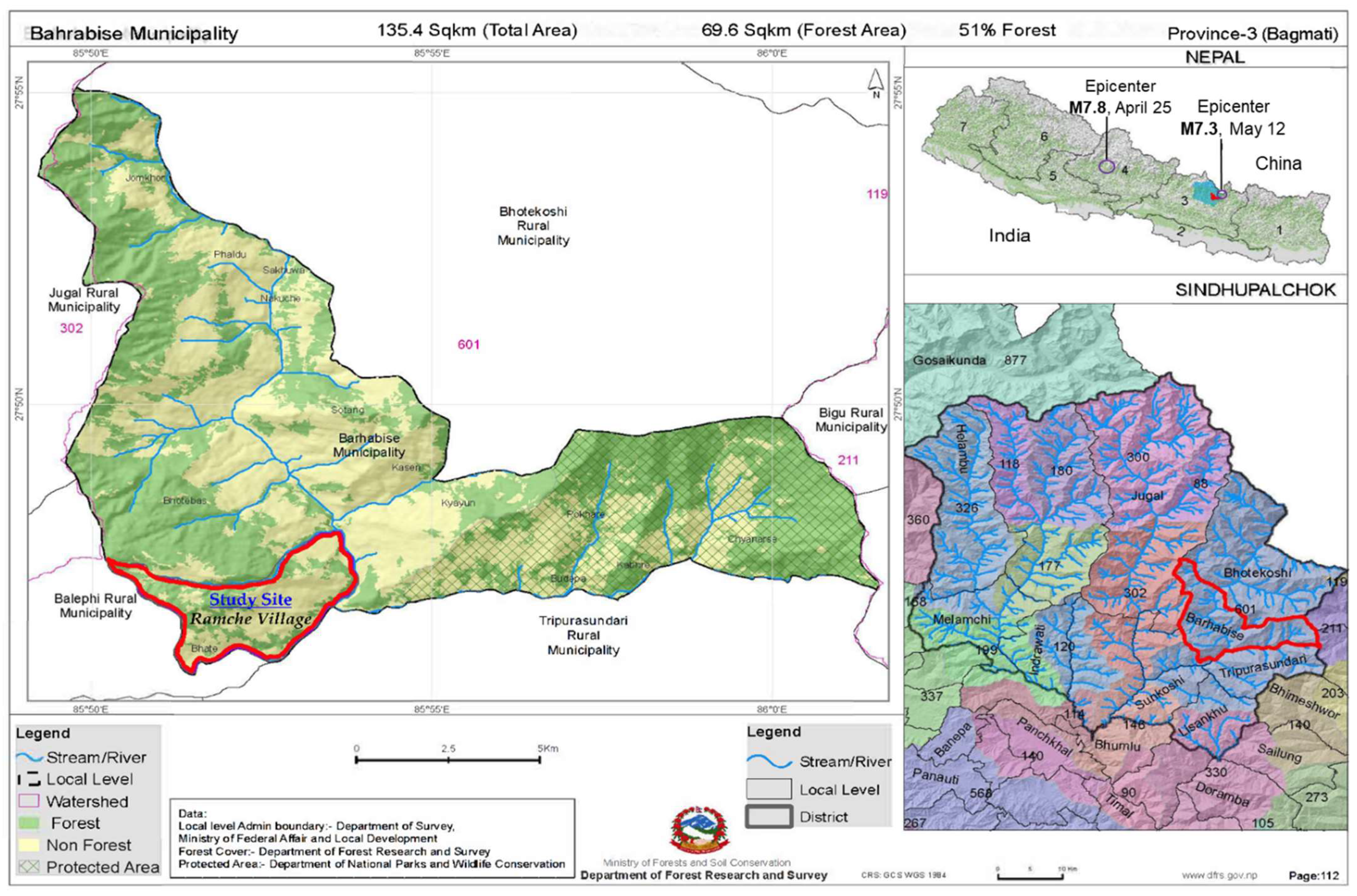
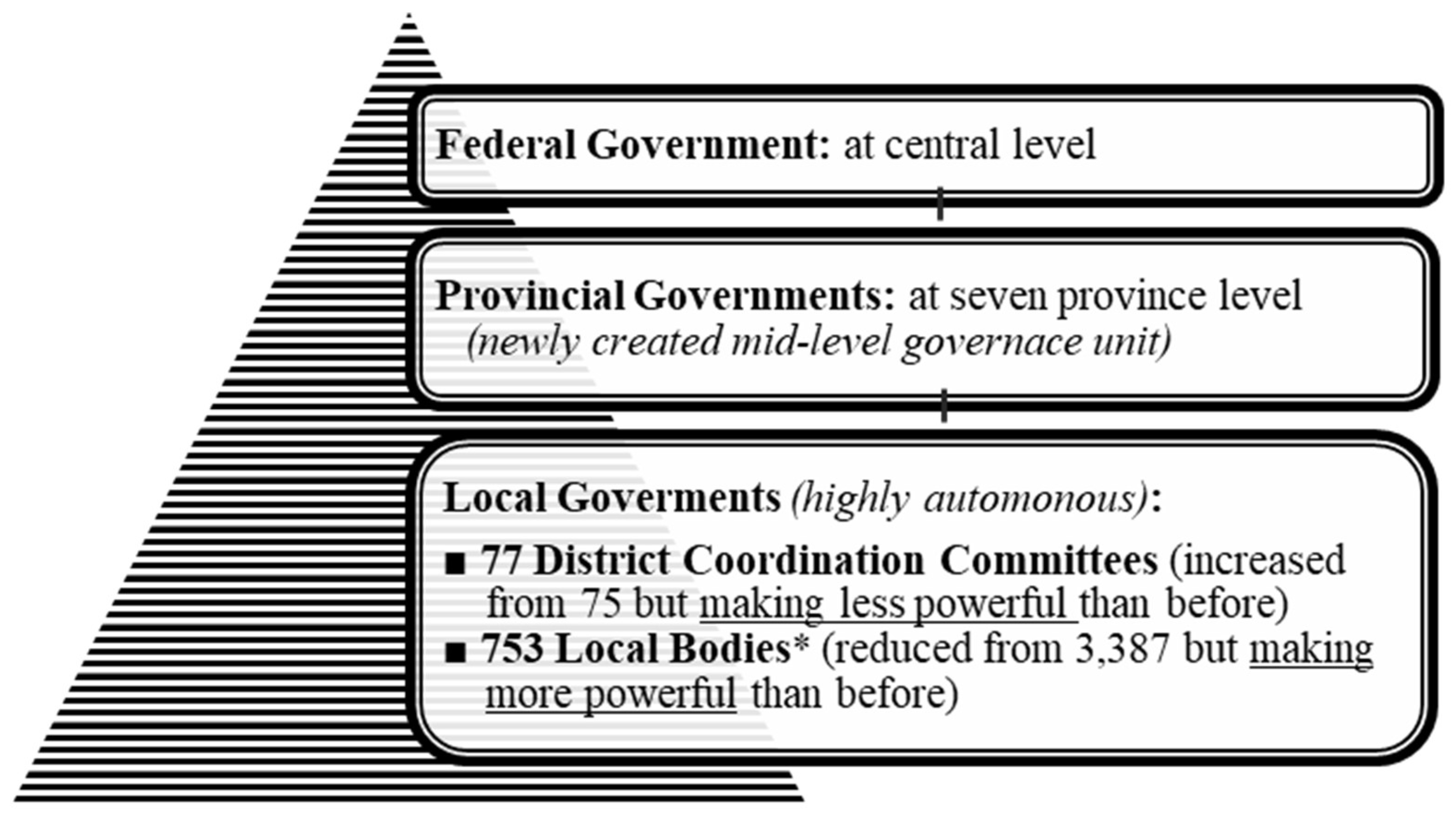
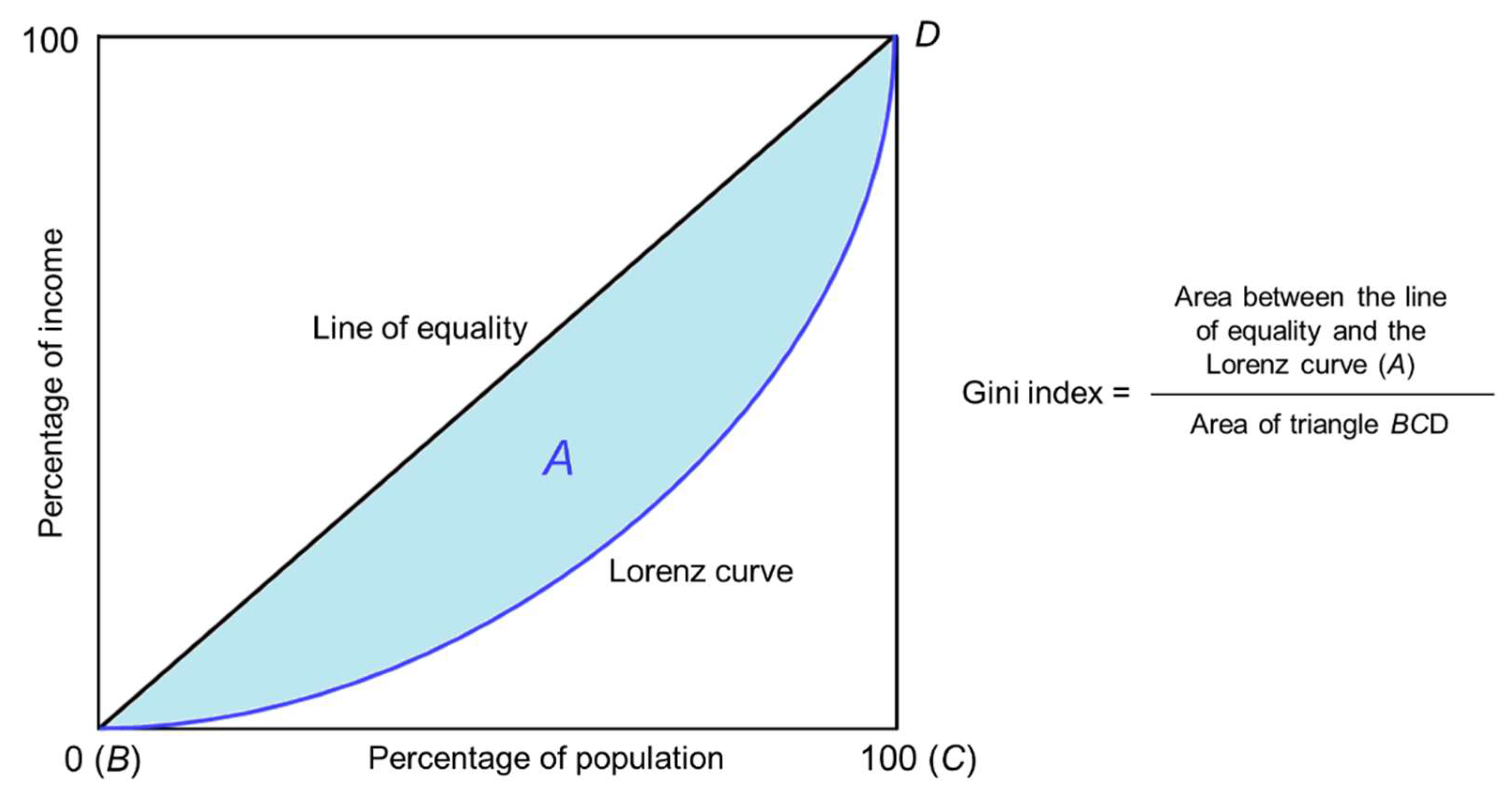


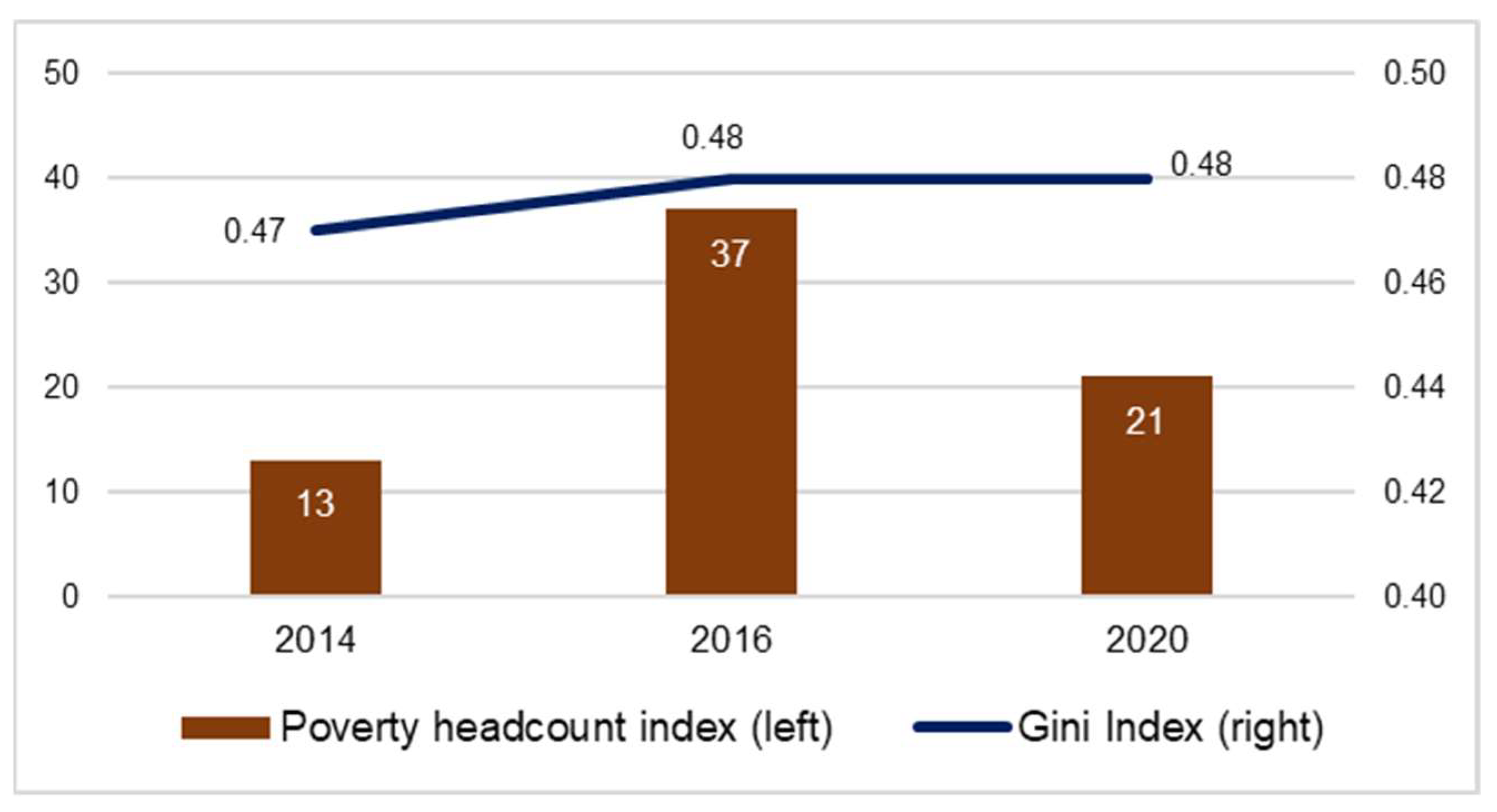
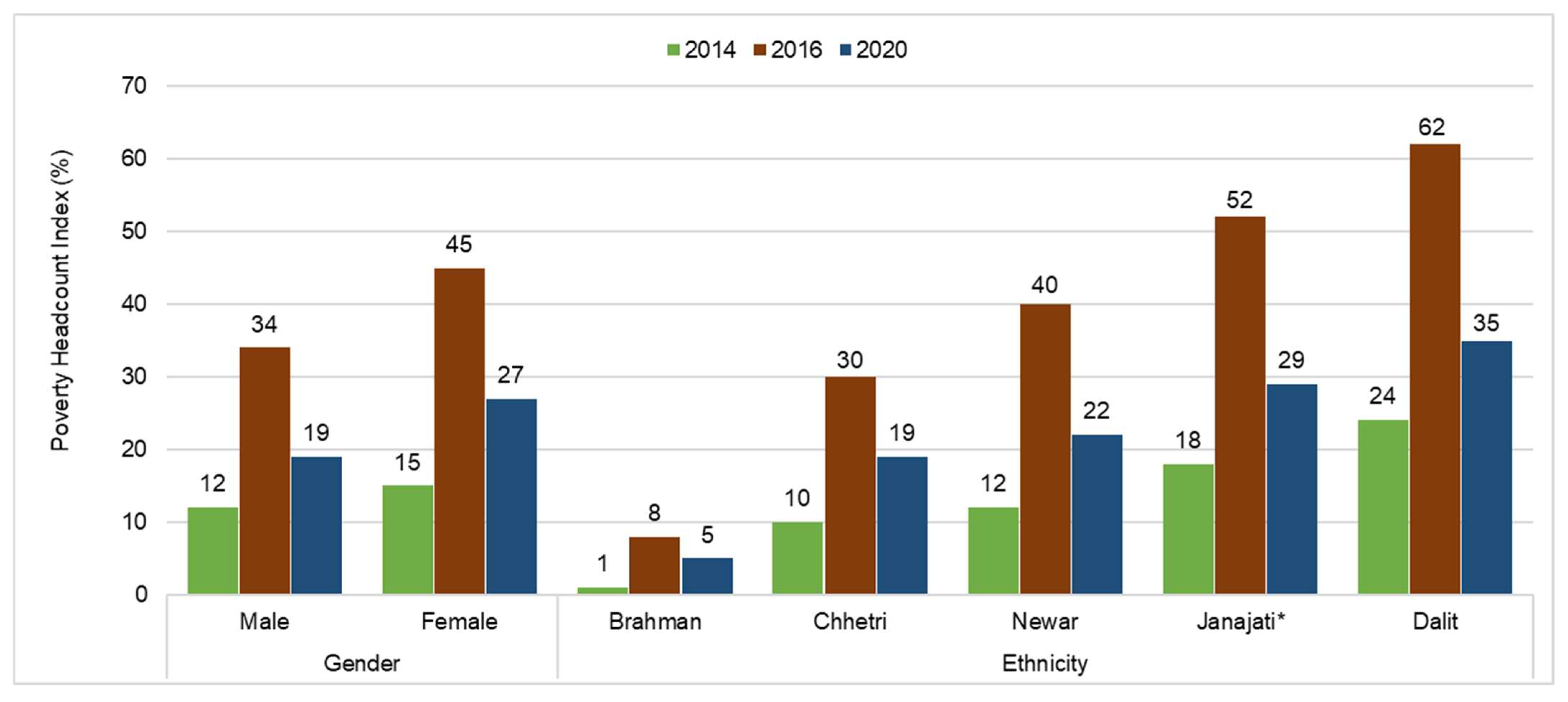
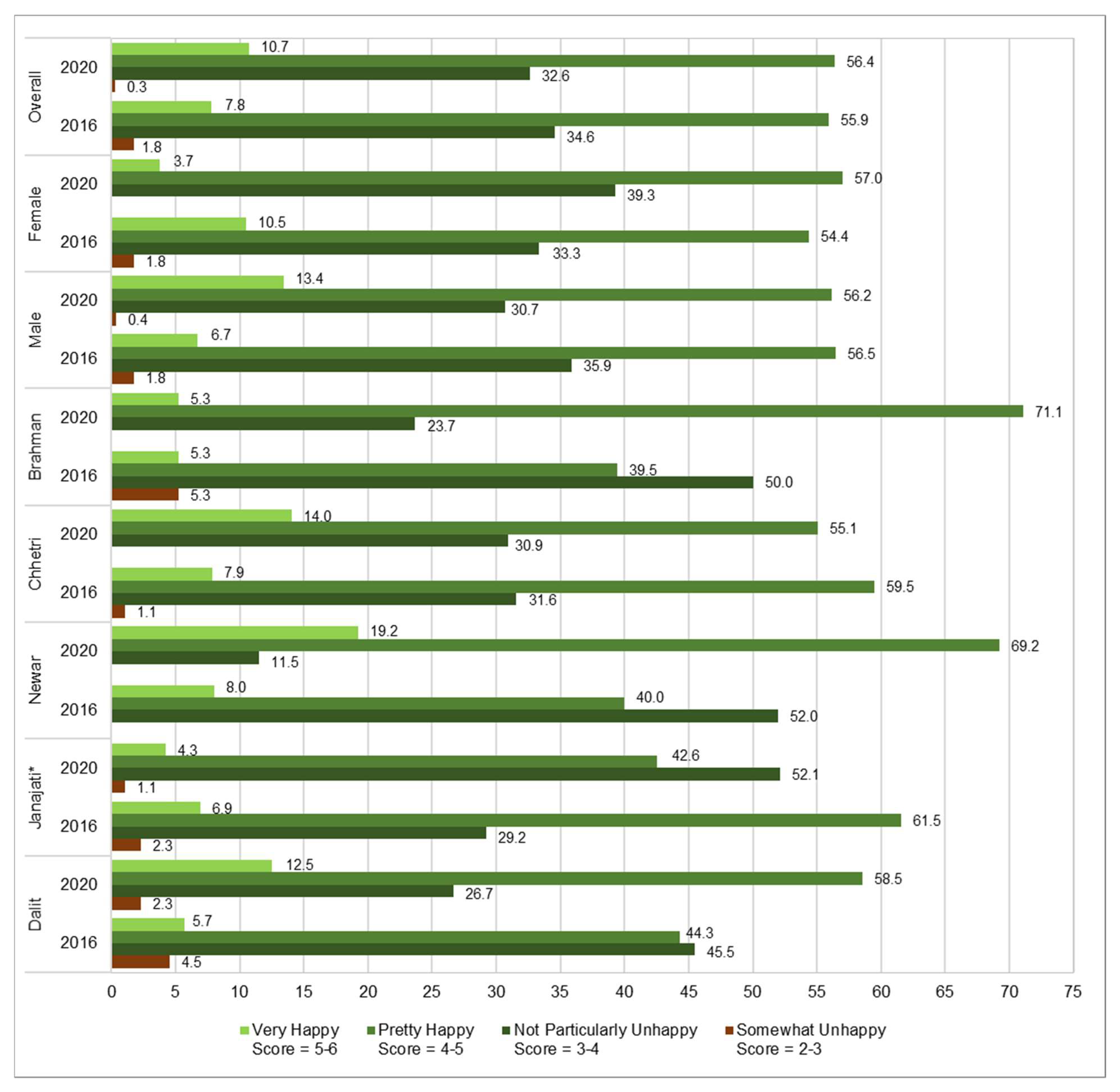
| Variables | Categories | Percent | Variables | Categories | Percent |
|---|---|---|---|---|---|
| Age | Up to 39 yrs | 32 | Gender | Male | 71 |
| 40–49 yrs | 28 | Female | 29 | ||
| 50–59 yrs | 20 | Caste/Ethnicity | Brahman | 10 | |
| 60 yrs and older | 20 | Chhetri | 47 | ||
| Religion | Hindu | 71 | Newar | 6 | |
| Buddhist | 23 | Janajati * | 33 | ||
| Kirat | 3 | Dalit | 4 | ||
| Others | 3 |
| Score | Meaning | Brief Interpretation and Advice |
|---|---|---|
| 1–1.9 | Not happy | Respondents in this group are probably seeing their situation as worse than it really is. They might be in depression. |
| 2–2.9 | Somewhat unhappy | The respondents in this group may need counseling. |
| 3–3.9 | Not particularly happy or unhappy | A score of 3.5 is the exact numerical average of the range of the possible answer, 1–6. Respondents in this group can improve their happiness level significantly with some mental exercise.* |
| 4 | Somewhat happy or moderately happy | Satisfied. The average person’s score remains around 4. |
| 4.1–4.9 | Rather happy; pretty happy | Respondents in this group are happy. |
| 5–5.9 | Very happy | Such respondents are more likely to have better health and better relationships and achieve life goals. |
| 6 | Too happy | This is not a likely score. |
Publisher’s Note: MDPI stays neutral with regard to jurisdictional claims in published maps and institutional affiliations. |
© 2021 by the authors. Licensee MDPI, Basel, Switzerland. This article is an open access article distributed under the terms and conditions of the Creative Commons Attribution (CC BY) license (https://creativecommons.org/licenses/by/4.0/).
Share and Cite
Sapkota, J.B.; Kurita, K.; Neupane, P. Progress after the 2015 Nepal Earthquake: Evidence from Two Household Surveys in One of the Hardest-Hit Mountain Villages. Sustainability 2021, 13, 11677. https://doi.org/10.3390/su132111677
Sapkota JB, Kurita K, Neupane P. Progress after the 2015 Nepal Earthquake: Evidence from Two Household Surveys in One of the Hardest-Hit Mountain Villages. Sustainability. 2021; 13(21):11677. https://doi.org/10.3390/su132111677
Chicago/Turabian StyleSapkota, Jeet Bahadur, Kyosuke Kurita, and Pramila Neupane. 2021. "Progress after the 2015 Nepal Earthquake: Evidence from Two Household Surveys in One of the Hardest-Hit Mountain Villages" Sustainability 13, no. 21: 11677. https://doi.org/10.3390/su132111677
APA StyleSapkota, J. B., Kurita, K., & Neupane, P. (2021). Progress after the 2015 Nepal Earthquake: Evidence from Two Household Surveys in One of the Hardest-Hit Mountain Villages. Sustainability, 13(21), 11677. https://doi.org/10.3390/su132111677







